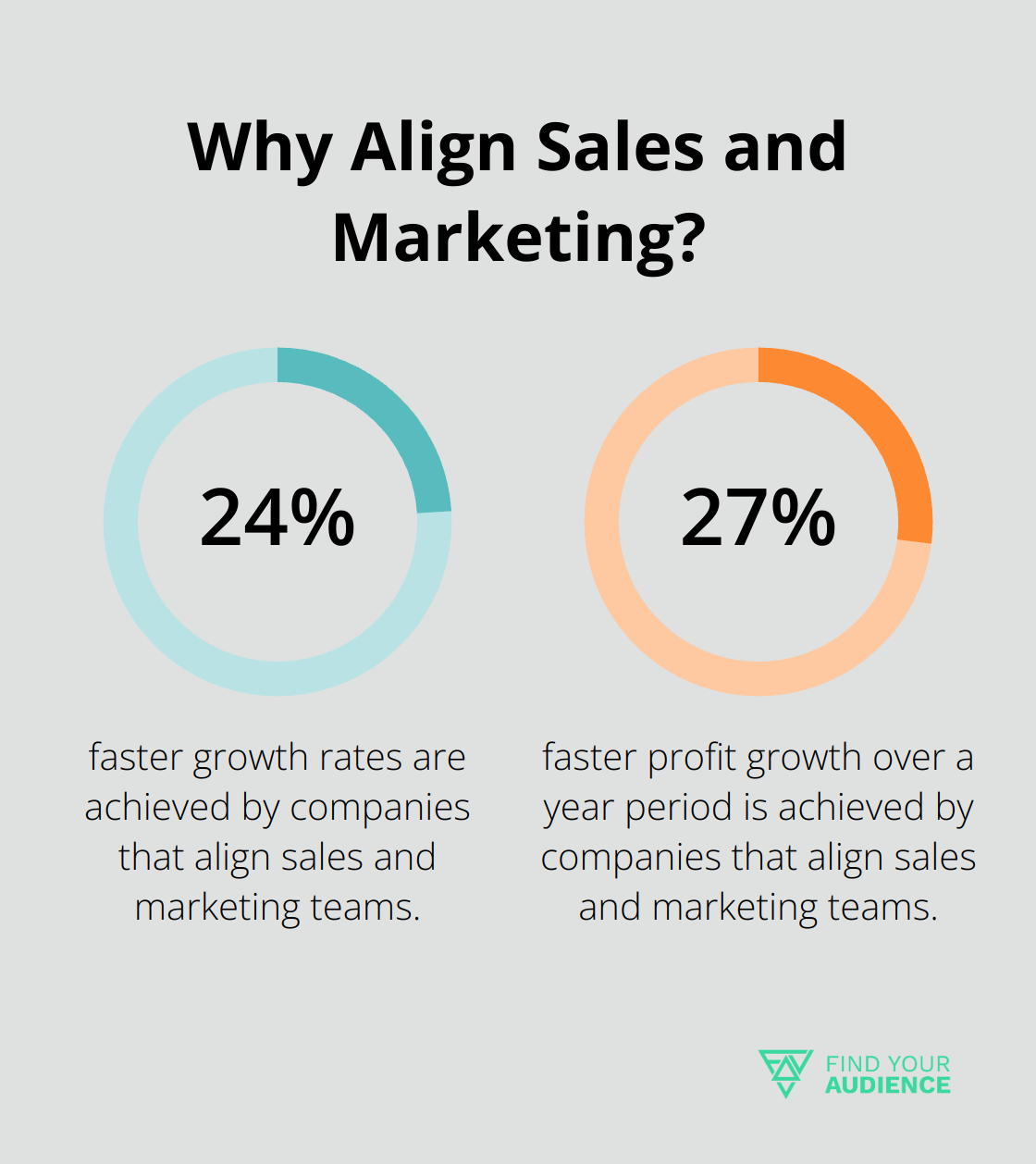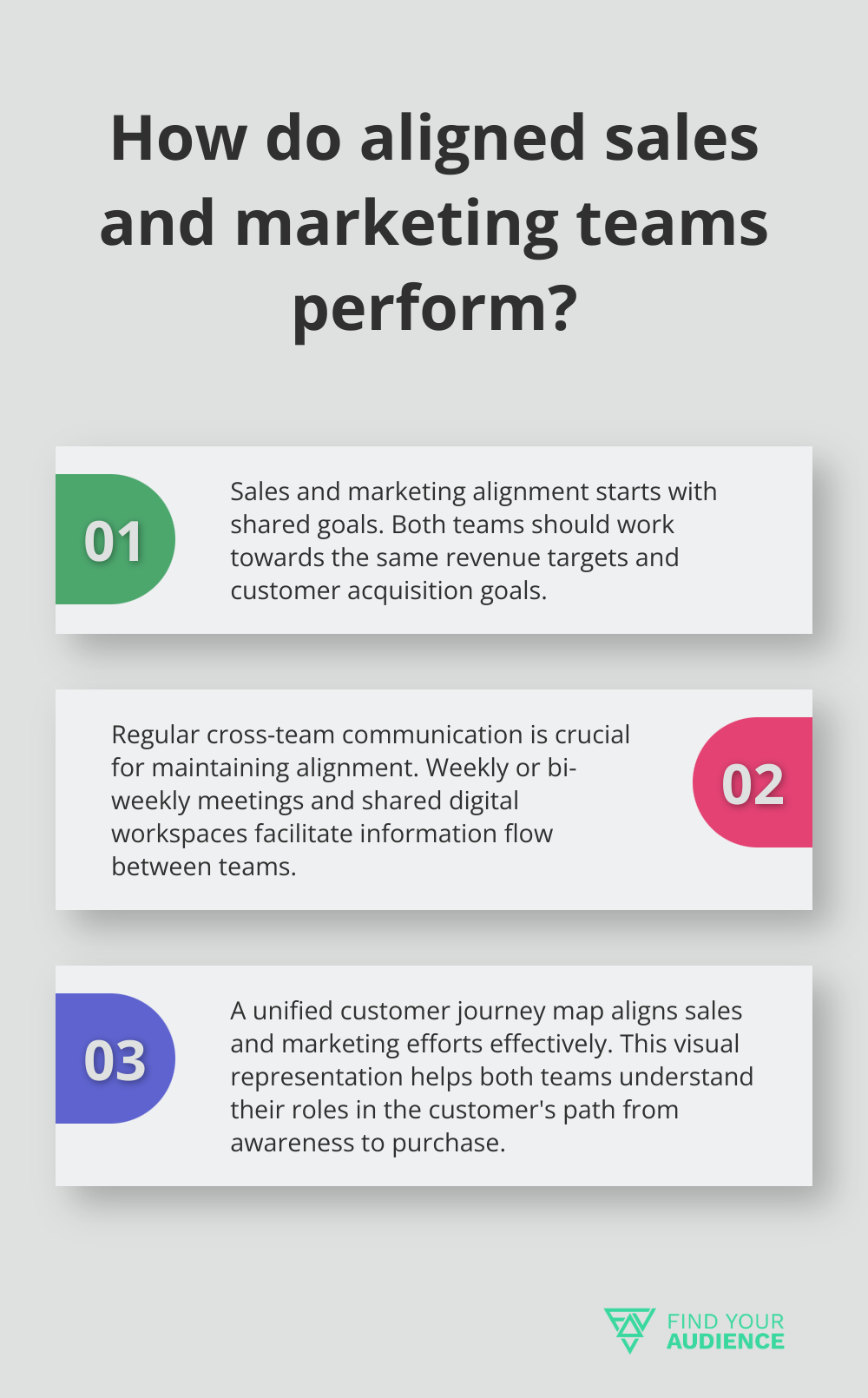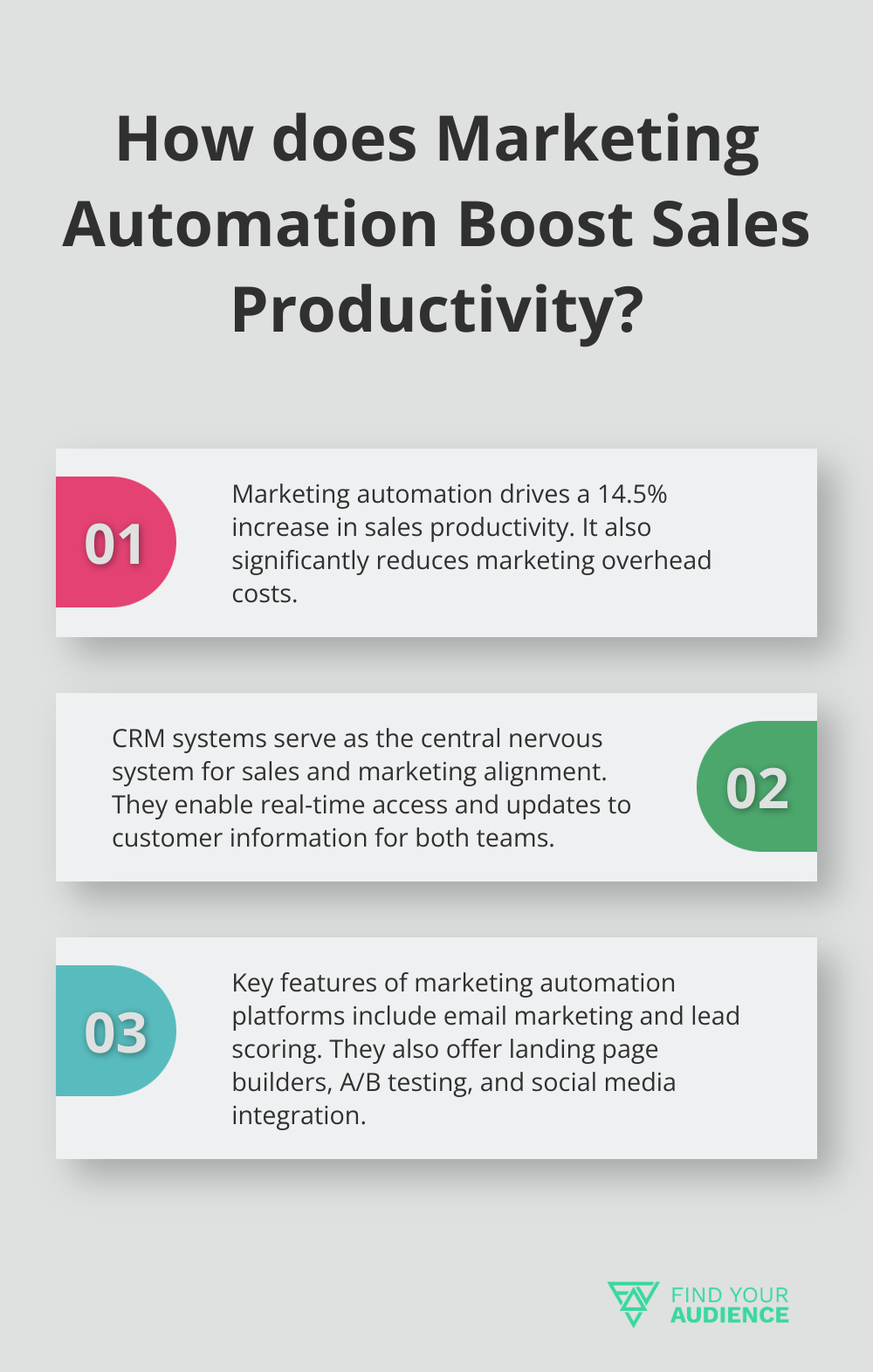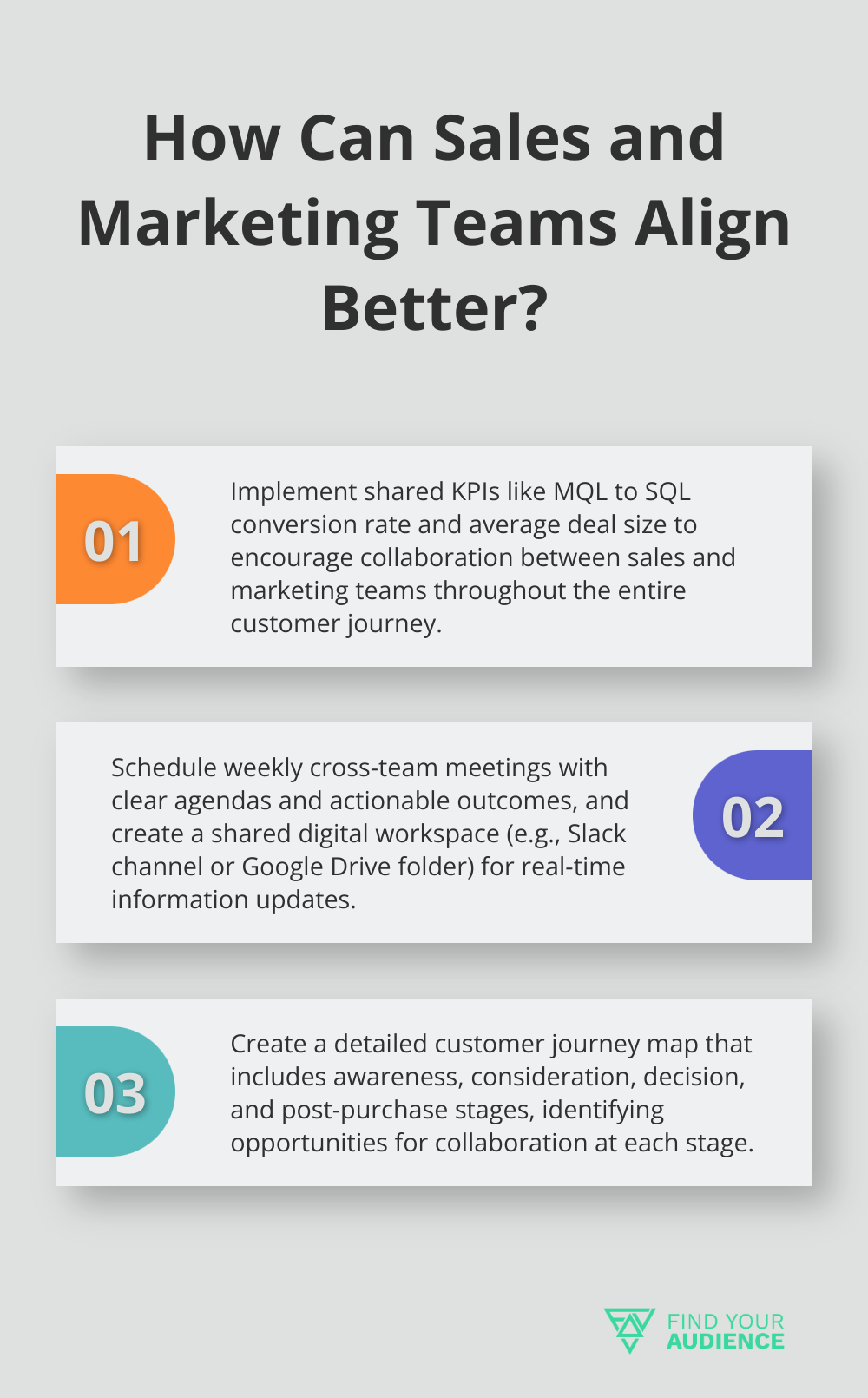Synergizing Sales and Marketing in SaaS
In the fast-paced world of SaaS, aligning sales and marketing efforts is no longer optional-it’s essential for success. At Find Your Audience, we’ve seen firsthand how SaaS sales and marketing synergy can dramatically boost revenue and customer satisfaction.
This blog post will explore practical strategies for unifying these crucial teams, along with the tools that make it possible. Get ready to transform your SaaS business with actionable insights and proven techniques.
Why Sales and Marketing Alignment Matters in SaaS
In the SaaS industry, the alignment of sales and marketing teams is not just a nice-to-have-it’s a game-changer. Companies who successfully bridge the gap between these two departments see remarkable improvements across the board.
Revenue Growth Through Unified Teams
When sales and marketing work in harmony, revenue growth follows. Companies that align sales and marketing teams achieve 24% faster growth rates and 27% faster profit growth over a year period. This isn’t surprising-when both teams are on the same page, leads become better qualified, and the sales process becomes more efficient.
Lower Customer Acquisition Costs
Aligned teams also lead to more cost-effective customer acquisition. This means you’re not just getting more customers-you’re keeping them longer, too.
Smarter Resource Allocation
One of the most significant benefits of sales and marketing alignment is improved resource allocation. When teams work together, they can identify which strategies work and which don’t. This allows for smarter budget decisions and more targeted campaigns.
Enhanced Customer Experience
Alignment isn’t just about agreeing on goals-it’s about creating a seamless experience for your potential customers from their first interaction with your brand to the moment they sign on the dotted line. When sales and marketing teams are in sync, they can create a consistent message and experience throughout the customer journey, leading to higher satisfaction and loyalty.
Data-Driven Decision Making
When sales and marketing teams align, they can share valuable data and insights. This collaboration leads to more informed decision-making (based on a holistic view of the customer journey). For instance, marketing can use sales data to refine their targeting, while sales can leverage marketing insights to tailor their pitches more effectively.

As we move forward, we’ll explore specific strategies you can use to foster this alignment in your own organization. These practical approaches will help you transform your sales and marketing teams into a unified force for growth and success.
How to Align Sales and Marketing Teams
Set Shared Goals and KPIs
The alignment of sales and marketing teams starts with establishing common objectives. Both teams should work towards the same revenue targets, customer acquisition goals, and retention rates. Instead of separate lead generation and closed deal targets, create a shared pipeline goal. This approach encourages collaboration throughout the customer journey.

Implement shared KPIs that reflect joint efforts. These might include:
- Marketing Qualified Leads (MQLs) to Sales Qualified Leads (SQLs) conversion rate
- Average deal size
- Customer Lifetime Value (CLV)
- Net Promoter Score (NPS)
By focusing on these shared metrics, both teams become invested in the entire sales process (from initial awareness to closed deals and beyond).
Establish Regular Cross-Team Communication
Frequent, structured communication maintains alignment. Schedule weekly or bi-weekly meetings where sales and marketing teams share insights, discuss challenges, and brainstorm solutions. These meetings should have a clear agenda and actionable outcomes.
Create a shared digital workspace where both teams can access and update information in real-time. This could be a dedicated Slack channel, a shared Google Drive folder, or a custom internal portal. The goal is to ensure that information flows freely between teams.
Encourage job shadowing or rotation programs. Have marketers join sales calls or salespeople participate in marketing campaign planning sessions to foster mutual understanding and respect.
Create a Unified Customer Journey Map
A comprehensive customer journey map aligns sales and marketing efforts effectively. This visual representation of the customer’s path from awareness to purchase helps both teams understand their roles in the process.
Start by gathering data from both teams about customer touchpoints, pain points, and decision-making factors. Use this information to create a detailed map that includes:
- Awareness stage: How customers first learn about your solution
- Consideration stage: The research and evaluation process
- Decision stage: Final steps before purchase
- Post-purchase: Onboarding, support, and retention efforts
Identify opportunities for collaboration at each stage. For example, marketing can create targeted content for specific objections that sales commonly encounter, while sales can provide feedback on which marketing materials close deals most effectively.
Leverage Technology for Seamless Integration
The right tools can significantly enhance sales and marketing alignment. Customer Relationship Management (CRM) systems serve as a central hub for customer data, allowing both teams to access and update information in real-time. Marketing automation platforms streamline lead nurturing processes, ensuring that leads are properly qualified before reaching the sales team.
Analytics tools provide valuable insights into the effectiveness of joint efforts. They help track shared KPIs and identify areas for improvement. Try to implement a unified dashboard that displays key metrics for both teams, fostering transparency and accountability.
These strategies create a more cohesive, efficient, and effective revenue-generating machine. Alignment requires ongoing commitment from both teams and support from leadership. The next section will explore the specific tools and technologies that can further enhance this synergy between sales and marketing teams.
Tech Tools for Sales and Marketing Harmony
CRM Systems: The Foundation of Alignment
Customer Relationship Management (CRM) systems act as the central nervous system for sales and marketing alignment. These platforms enable both teams to access and update customer information in real-time, ensuring everyone works with the most current data.

When selecting a CRM, look for these features:
- Customizable dashboards for both sales and marketing teams
- Automated lead scoring and routing
- Integration capabilities with other tools in your tech stack
- Mobile access for on-the-go updates
Marketing Automation: Lead Nurturing at Scale
Marketing automation platforms eliminate the grunt work from lead nurturing, allowing marketing teams to create personalized, timely communications at scale. These tools can significantly impact lead quality and conversion rates.
A study shows that marketing automation drives a 14.5% increase in sales productivity and a significant reduction in marketing overhead. When integrated with your CRM, these platforms create a seamless handoff between marketing and sales.
Key features to consider in a marketing automation platform include:
- Email marketing capabilities
- Landing page and form builders
- Lead scoring and segmentation
- A/B testing functionality
- Integration with social media platforms
Analytics Tools: Measuring Joint Success
Analytics tools provide the data-driven insights necessary to measure and improve sales and marketing efforts. These platforms help teams track shared KPIs, identify trends, and make informed decisions.
Google Analytics (a free tool used by millions of websites) can provide valuable data on website traffic, user behavior, and conversion rates. For more advanced analytics, tools like Mixpanel or Amplitude offer deeper insights into user engagement and retention.
When selecting analytics tools, prioritize:
- Real-time reporting capabilities
- Custom dashboard creation
- Multi-channel attribution modeling
- Predictive analytics features
- Easy data visualization options
The right combination of these tools can transform sales and marketing alignment. Many companies report significant improvements in lead quality, conversion rates, and overall revenue growth after implementing a cohesive tech stack.
The key to success with these tools lies not just in their implementation, but in how well your teams use them collaboratively. Regular training sessions and clear processes for data sharing and analysis maximize the benefits of your tech investments.
Final Thoughts
The alignment of sales and marketing teams in SaaS companies drives substantial business growth. This powerful strategy increases revenue, improves customer acquisition and retention, and allocates resources more efficiently. It creates a seamless customer journey, which enhances overall satisfaction and loyalty.

SaaS sales and marketing synergy is essential for companies to thrive in today’s competitive landscape. Companies must set shared goals, maintain regular cross-team communication, and create a unified customer journey map. They should also leverage technology such as CRM systems, marketing automation platforms, and analytics tools to enable seamless integration and data-driven decision-making.
Find Your Audience specializes in helping SaaS companies achieve this alignment. Our fractional marketing team can integrate with your existing structure, providing expertise and resources to drive pipeline growth. We offer tailored solutions to maximize your SaaS sales and marketing efforts (visit our website to learn more).

